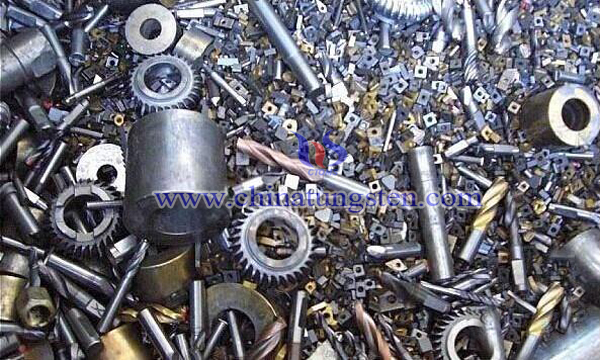Cemented-Carbide Grinding Material Recycles Tungsten
- Details
- Category: Tungsten Information
- Published on Monday, 05 February 2018 12:09
Cemented-carbide grinding material not only contains a considerable amount of tungsten, but also a small amount of cobalt and nickel and other valuable metals, which can realize comprehensive utilization of secondary resources of tungsten if it is recycled. Currently, as for recovery process of the metal of such waste-tungsten materials there are some common methods, such as oxidation-alkali leaching, saltpetre melting, sodium-sulphate-melting, and so on. The saltpetre smelting and sodium-sulphate-smelting methods has the disadvantages of high-energy consumption and impurities, so oxidation - alkali leaching method is generally used.
However, a certain amount of tungsten was found to be dispersed in the leachate during the process of real manufacture. The reason for such situation is that the cemented-carbide grinding material also contains tungsten in the form of tungstate and a part of the tungstate soluble in acid makes it possible for this part of tungsten to easily enter the leachate during alkali-leaching. Thereby on the one hand causing a loss of tungsten dispersion and a reduction of tungsten recovery, on the other hand, during the process of recovery and purification of valuable metals such as cobalt and nickel in the leachate, the presence of tungsten will inevitably increase the cost of the process, affecting the separation and purification of the process.
In inrder to solve the above technical problems, some scholars have improved the leaching technology scheme and achieved good results. The scheme consists of the following steps:
Acid leaching: The cemented-carbide grinding material is subjected to acid leaching until the mass percentage of cobalt-nickel in the leaching residue is less than the preset value to obtain the leaching solution, the leachate obtained.
Tungsten precipitation recovery: After acid-leaching qualified, dealing with the leachate with soluble-ammonium salt or ammonia as a precipitating agent. And then the flocculant is used to coagulate the tungsten-precipitate formed in the leachate and finally filtered and recovered condensed tungsten-precipitation.
1) The sample of cemented-carbide grinding material was obtained by multi-point random-sampling method, and the concentration of element was analyzed and detected. The mass percentages of the samples were 94.32% of WO3 , 5.26% of Co, 0.13% of Ni, 2.62% of Fe, 0.08% of Cr, 0.002% of Mo, 0.01%V, 1.33% of Cu, 27.92% of moisture;
2) Take 2kg grinding material and mix it with water by solid-liquid mass ratio of 1: 1 to obtain serosity
3) The serosity is acid-leached with sulfuric-acid at 75 ° C until the amount of cobalt and nickel in the insoluble slag is less than 3%, and the leachate was obtained. The content of tungsten in the leachate was 1.87 g / L by sampling and analysis.
4) When the temperature of leachate obtained by acid-leaching is reduced to 45 ° C, add 300g of ammonium sulfate to the reaction system for 2 hours, and then add 0.4g of polymerized ferric sulfate. And the mixture is allowed to stand for 0.5 hours to filter after stirring. Take the filtrate to analyze that the content of tungsten is 0.06 g / L. The whole process can make the content of W in the leaching solution decreased from 1.87g / L to 0.06g / L, the recovery rate of scattered-tungsten is of 97%.
The above recovery-method firstly adopts the method of acid leaching to dissolve the cobalt, nickel and other metals in the cemented-carbide grinding material, and then precipitates the tungsten in the leaching solution by the method of ammonium salt or ammonia precipitation to finally make the tungsten-dispersion loss in the acid-leaching process lower than 0.3g / L. The recovery rate of dispersed tungsten is higher than 97%. This method can recycle tungsten dispersed in acid solution, so as to maximize to recycle tungsten and other valuable metals for subsequent comprehensive recovery of tungsten and cobalt, nickel.
- Tungsten Carbide Manufacturer & Supplier, Chinatungsten Online: tungsten-carbide.com.cn
- Tungsten News & Prices of China Tungsten Industry Association: www.ctia.com.cn
- Molybdenum News & Price: news.molybdenum.com.cn
- Tel.: 86 592 5129696; Fax: 86 592 5129797; Email: sales@chinatungsten.com



 sales@chinatungsten.com
sales@chinatungsten.com